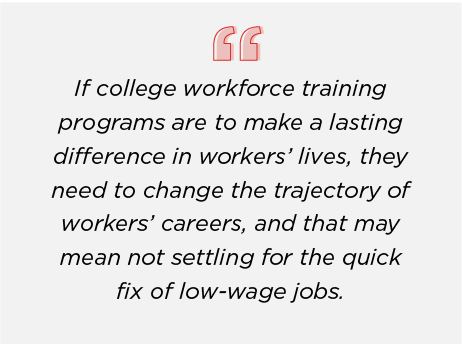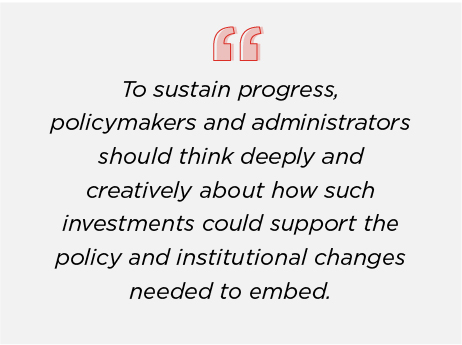Strategies for Success: How To Boost Students’ College Completion and Earnings

This is a critical moment for our nation’s economy, employers, and workers. The COVID-19 pandemic has exposed and widened existing economic divides and has disproportionately harmed workers with lower levels of education. Policymakers are seeking to help these workers reverse their losses and advance from low-wage jobs to family-sustaining employment. One way to address that challenge is to get more people access to education and training that prepare them for better jobs and to make that education and training more effective. Community and technical colleges can play a central role in in this effort if they can boost their often low completion rates and guide more students toward credentials that can pay off substantially in the labor market.
The career pathways approach provides colleges one strategy for reaching these goals. This approach trains people for a series of occupations in an industry sector that require progressively higher levels of skill and offer increasing levels of pay. This approach also offers students comprehensive support inside and outside the classroom. In this blog, we outline strategies that community and technical colleges can use to boost students’ college completion rate and earnings.

Career pathways programs substantially increase credential completion and employment in targeted industries, but often do not improve earnings. Research by Abt and others on the impact of career pathways programs finds that these programs on average substantially increased students' receipt of postsecondary credentials and increased employment in the industries targeted. However, programs increased earnings by only a small average amount in the short term, and not at all after three or more years. These overall results mask wide variation in the interventions studied, their impacts and goals, their program structures and services, the industries and occupations they targeted, and the populations they served.
A closer look at research suggests that larger earnings impacts are associated with characteristics more commonly found in private, nonprofit sector training programs than in community college programs. These types of training programs tend to have stronger employer partnerships than community college programs typically do and are highly selective, where community college training programs serve a much wider range of applicants. They also spend more per participant than colleges, target industries other than health care more often, and are more likely to have tightly defined models.
With federal and state aid, colleges could help more adults complete credentials and boost their earnings by combining features of proven career pathways and sector training approaches with other approaches. A broader look at rigorous evidence on these approaches suggests colleges could improve student results by bundling several strategies:
1. Target family-supporting jobs and careers from the outset, rather than focusing on low-wage jobs initially and assuming workers will return for further education and credentials later. Many career pathways and other training programs prepare students for the same low-wage jobs that less educated workers are likely to obtain on their own, such as nursing aide positions. Policymakers and practitioners may believe such jobs are just a first step and students will return later for higher-level training for better jobs, but research indicates that most career pathways students who enroll in entry-level training do not return for higher-level training.
If college workforce training programs are to make a lasting difference in workers’ lives, they need to change the trajectory of workers’ careers, and that may mean not settling for the quick fix of low-wage jobs. This approach involves trade-offs; for example, there may be higher attrition in longer programs and less access for those with lower levels of basic skills since programs of this type are more challenging academically. Such programs are not the right fit for everyone. But it is likely that more workers could enter and complete higher-level training for better-paying jobs if they received support to do so. In addition, research finds that broad, transferable skills may play a major role in determining which students move up to higher-paying jobs over time, suggesting that skills such as problem-solving and communication should also be incorporated into training efforts aimed at career advancement.
2. Combine high expectations with high levels of structure and comprehensive support to tackle multiple barriers to completion simultaneously. The most successful sector training programs include certain common elements that encourage commitment and support completion.
First, these programs are more structured than the typical community college experience. For example, leading sector training programs such as Per Scholas and Year Up require full-time attendance. Second, these programs require students to participate in intensive academic and career advising, and they also help students address personal, work, and family issues that can derail success. Third, they cover most or all training costs. Year Up even provides participants with stipends for its six months of training and an additional six months in internships. Such stipends at community colleges could make full-time attendance more feasible, especially for adult learners, for whom living expenses such as rent, food, and transportation can present a central challenge to pursuing longer, higher-level training programs.
3. Expand access to high-quality training for students at all levels by incorporating academic support and adopting reforms that help students move into college courses more quickly. Gaps in academic preparation can often pose insurmountable roadblocks to entering and completing training. Washington State’s I-BEST instructional model, which combines “contextualized” basic skills instruction with career training, shows it is possible to double the number of students who complete credentials for those whose low test scores or lack of a high school diploma would typically keep them out of training.i Another strategy for enabling students to move into college courses more quickly is to use high school grades and not just test scores for placement decisions, which allows more students to show they can bypass basic skills classes. And some training programs, such as Project Quest and VIDA, offer intensive, short bridge courses to help students prepare for placement tests and college-level work.
4. Connect the college experience much more closely to career outcomes through industry partnerships and work-based learning. Improving these connections can boost students’ earnings. Work-based learning may also help more students complete credentials by providing them with opportunities to apply skills. Inequality in the labor market is not just a consequence of inequality in education, so improving credential completion alone cannot fix it. Systematic biases, especially against people of color and women, social networks that limit which jobs and employers workers can connect to, and employers’ strong preference to hire those who already have relevant work experience can all combine to make it difficult for people to get access to employers and careers that offer family-supporting wages. Work-based learning can help offset those disadvantages by using a college or training program’s relationships and credibility to open doors. Year Up’s paid internships in professional settings, for example, are viewed as integral to its success in producing sustained earnings increases (of 38 percent after five years) for young adults, most of whom are people of color. Apprenticeships, many of which involve community colleges as a training partner, provide an opportunity for work-based learning to increase both college completion rates and earnings. Moreover, apprenticeships address equity by expanding to non-traditional populations and occupations.

New federal and state investments could spur substantial progress toward higher college completion rates and boost students’ earnings by incorporating these evidence-based strategies. To sustain progress, policymakers and administrators should think deeply and creatively about how such investments could support the policy and institutional changes needed to embed these strategies into community colleges so that they become standard practice.
This blog is based on a recent publication by Julie Strawn, formerly of Abt Global, featured in MDRC’s College Completion Strategy Guide.
